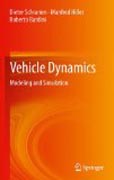
Vehicle dynamics: modeling and simulation
Schramm, Dieter
Hiller, Manfred
Bardini, Roberto
The authors examine in detail the fundamentals and mathematical descriptions of the dynamics of automobiles. In this context different levels of complexitywill be presented, starting with basic single-track models up to complex three-dimensional multi-body models. A particular focus is on the process of establishing mathematical models on the basis of real cars and the validation of simulation results. The methods presented are explained in detail by means of selected application scenarios. Professor Dieter Schramm has been the Chair of Mechatronics since 2004 andserves as the Dean of the Faculty of Engineering at the University of Duisburg-Essen. Before that time and after receiving his Phd in Engineering from the University of Stuttgart he worked over a period of more than 18 years in various positions in the automotive industry. Starting as section manager at the Robert Bosch Company he later held positions as a department head and from 1999 as director of engineering and marketing for various product segments, as wellas being the CEO of the affiliated company Tyco Electronics Ltd. His main scientific focus is on vehicle dynamics, vehicle safety and driver assistance systems.Professor M. Hiller was the first Chair of Mechatronics in Germany from 1991 to 2004 at the University of Duisburg (today the University of Duisburg-Essen). During his time in Duisburg (from 1987), and before that during his time at the University of Stuttgart he dealt with the modeling and simulation of road vehicles over more than three decades. As a consequence, he worked in close collaborations with major car manufacturers and car suppliers in Germany. In particular, he designed detailed multi-body system-based simulation models, thus providing a major contribution to the development of active and passive safetysystems like ESP and rollover prevention.Dr. Roberto Bardini has been working since March 2000 as a development engineer in the field of vehicle safety, first with Audi and since October 2003 withBMW. He has been engaged in the spatial multi-body simulation of occupants and vehicles since completing his mechanical engineering degree in 1996 at the Department of Mechatronics under the direction of Professor Hiller. Especially for the design of occupant protection systems to prevent vehicle rollover, he has developed simulation tools that have been successfully used in practice. INDICE: 1 Introduction 1.1 Characteristics 1.2 Problems 1.3 Motor-Vehicle Systems Requirements 2 Longitudinal Dynamics 2.1 Tires 2.2 Total Running Resistances 2.3 Motor-Vehicle Drives 2.4 Drivetrain 2.5 Brakes 3 Vertical Dynamics 3.1 Spring- and Damper Components 3.2 Excitation provided by the Roadway Surface 3.3 Quarter-Car Model 3.4 Singel-Track Suspension Model 3.5 Double-Track Suspension Model 4 Tires 4.1 Requirements 4.2 Construction Methods of Tires 4.3 Tires under Vertical Forces 4.4 Tires under Tangential Forces 4.5 Tires under Lateral Forces 4.6 Superposition of Tangential- and Lateral Forces 5 Singel-Track Model 5.1 Estimates and Steering Kinematics 5.2 Equation of Motions (EQM) 5.3 Steady-State Steering Behaviour and Steady-State Skidpad Testing 5.4 Unsteady Steering Behaviour 5.5 Nonlinear Singel-Track Model 6 Wheel Suspensions 6.1 Basic Kinematics 6.2 Characteristics of Longitudinal Dynamics 6.3 Characteristics of Lateral Dynamics 6.4 Steering 7 4-Wheel Vehicle Model 7.1 Equation ofMotions 7.2 Steady-State Skidpad Testing 7.3 Longitudinal- and Lateral Dynamics 8 Kinematics and Dynamics of Multibody Systems 8.1 Fundamental Methods of Kinematics 8.2 Equations of Motion of Multibody Systems 8.3 Dealing with Kinematical Loops 8.4 Computer-Aided Design of Equations of Motion 9 Modelling of Vehicle Components 9.1 Chassis 9.2 Wheel Suspensions 9.3 Tires 9.4 Drive Train 10 Modelling and Simulation of Motor Vehicles 10.1 Modelling of an Overall Vehicle 10.2 Simulations of Motor Vehicles - FASIM C++ 10.3 Integration in a Commercial Simulation Environment 10.4 Example: Vehicle Model in Matlab/Simulink 10.5 Driver Model 10.6 Simulation of Motor Vehicles in Borderline Situations 10.7 Calculation of Avoidance Trajectories 11 Vehicle Systems 11.1 Vehicle-Dynamics Control Systems 11.2 Driving Comfort 11.3 Restraint Systems 11.4 Future Development 12 Literature
- ISBN: 978-3-540-36044-5
- Editorial: Springer
- Encuadernacion: Rústica
- Fecha Publicación: 01/07/2012
- Nº Volúmenes: 1
- Idioma: Inglés
